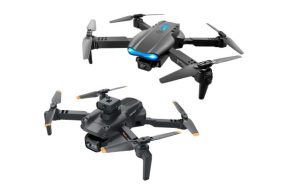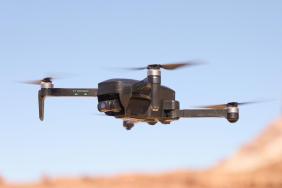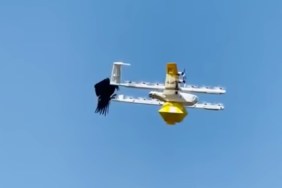We’ve recently gushed over the flash-forward success of UAVIA’s drone experiment in San Francisco. Unless you’ve been sequestered under a rock somewhere, you’ve probably heard rumblings about a group of young engineers who remote controlled a drone over the sunny streets of San Francisco…from their headquarters in Paris. And while this is just the tip of the iceberg in terms of what implications lay ahead for drone tech and autonomous tech of any sort, CEO and Founder Clement Christomanos was more than game to talk to us in depth about where we are headed.
CRAVE: Who is Uavia? And what exactly is the internet of drones?
Clement Christomanos: Uavia has been created by 4 young engineers almost three years ago now. After our classes in engineering school, we were playing with drones and we discovered their huge potential in lots of different fields : agriculture, mapping, industry… However, that potential was, by then, limited by technology. Drones were just flying sensors with no intelligence and limited interactivity.
We decided to bridge the gap between the Internet of Things and drones – making UAVs (Unmanned Aerial Vehicles) connected objects. Thanks to 4G/LTE connectivity and remote charging stations dispatched directly on-site, our drones can be controlled from any internet-connected computer in the world and perform real-time aerial inspection or surveillance, without human intervention in the field.

UAVIA has made it possible to pilot their drones remotely.
What ultimately led to the conceptualization of UAVIA? How did a group of young engineers decide to remote control a drone several thousand miles on the other side of the planet?
We had this idea of connecting drones since the end of 2013, after literally losing a wi-fi controlled recreational drone due to loss of the radio link. We’ve progressively conceptualized this idea into a business and pitched it during an entrepreneurship challenge for students – which we ultimately won. This allowed us to get our very first offices thanks to the business incubator Telecom & Management SudParis as well as regular coaching by mentors and experienced entrepreneurs.
The whole concept of what we call the Internet of Drones is for our users to be able to take control of their drone from anywhere and anytime. We had an opportunity to travel to San Francisco thanks to our business incubator. Then, we immediately thought of testing what we had been working on in the worst possible conditions – from our hotel room halfway across the globe.
How long has this been in the making? Help us understand what some of the practical obstacles you faced to launch the drone?
We had our very first prototype ready as quickly as two months ! But in the end, this has been in the making for the last three years – this is the difference between a horrible prototype, which flew thanks to a few miracles, and a heavy duty professional-grade UAV ready for use on operational scenarios in very demanding industries.
We’ve faced a lot of very interesting challenges – mainly regulatory obstacles, as well as technical ones. For instance, we had to design our technology to minimize the latency – a too large latency would make it very impractical for the end-user to control the drone – while guaranteeing security with real-time encryption techniques.

UAVIA reimagines the future of drone technology.
UAVIA participated with a host of other big names in San Francisco during workshops. What sort of exchange of ideas took place between you and stalwarts like Google and Facebook?
Moving to San Francisco was one of our best experiences. We’ve talked to a lot of experts from local companies, startup accelerators… Our most inspiring discoveries were done at Google, Facebook as well at Stanford’s d.school – the home of design thinking. More than exchanging about technique or business, these visits were more about exchanging practices and mindsets that made the Silicon Valley so special and so good at giving births to unicorns. We’ve made a special effort to keep that spirit going on in our offices in Paris and we wish we could have time to travel to SF more often !
What are the future implications for drones controlled from the cloud? Where do you think this will go in the next 5 years?
Drones will become smarter and smarter in the next few years thanks to their connection to the cloud. We had, from the beginning of Uavia, a strong vision on the potential of drones for multiple industries. Our drones aren’t just flying machines – these are pieces of flying software, able to analyze situations making lots of processes more efficient. For instance, our drones check periodically for overheating equipment on critical infrastructure. Whenever they detect something wrong, an alert is sent to an operator immediately, for him to take the appropriate actions.
Five years from now, drones will be a must have in heavy industries. Every day they will help grid operators to monitor critical infrastructure, they will help railway operators enhance security and performance, they will help first responders to get a better situation awareness during major disasters.

A rendering of a 4G network.
One of the gray areas is homeland security. How far are we away from having drones flying everywhere and controlled from the cloud? What is the major challenge to making this technology accessible to the masses ?
This question is very complex. Indeed, drones can both be very useful and also pose a threat to homeland security. We’re still very far from having drones flying everywhere and every day, controlled by the cloud or by some sort of artificial intelligence – this is science fiction. Not due to technical limitations, but due to regulatory ones. In every country, lawmakers have the heavy responsibility of ensuring drones won’t pose a threat to airspace safety as well as for homeland security while encouraging the digital revolution this technology is bringing.
On a different note, the UK has opted to leave the EU. As a European company, how do you foresee the UK’s BREXIT impacting design and tech exchange in the EU and with the UK? Are you disappointed by this decision? What might the repercussions be for France?
Of course, we are disappointed by this decision. The UK has always been a major business partner for french companies. Neither UK, France or Europe will benefit from this situation. As for the direct consequences, it is too soon to foresee anything. The actual Brexit will be effective in at least a few years and a smooth transition should minimize short-time impact. But on a personal note, I can only regret a vote that is largely based on a lack of open-mindedness and that poses a heavy threat to the construction of a stronger Europe.
What’s next on the horizon for UAVIA? Any news that we should be on the lookout for ?
Stay tuned ! Uavia will be expanding fast during the next few months. Although I can’t say more, we have lots of projects with large companies in France and in Europe.








